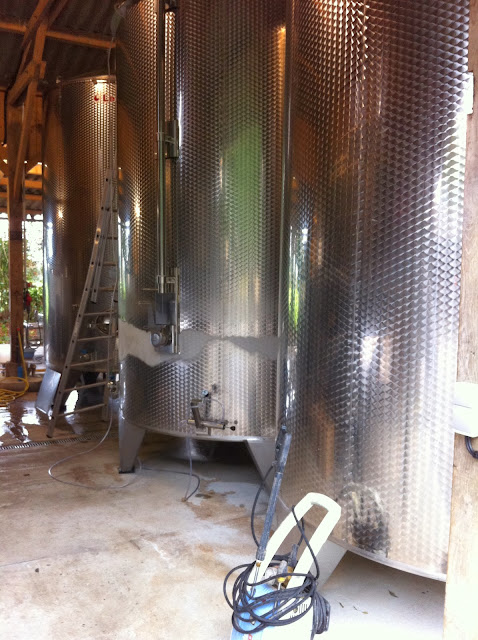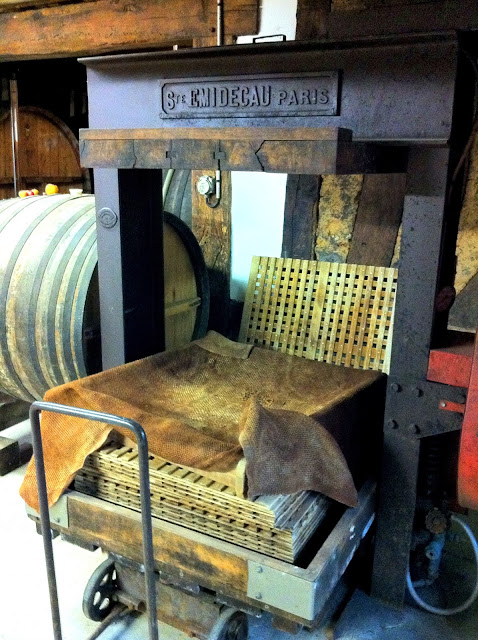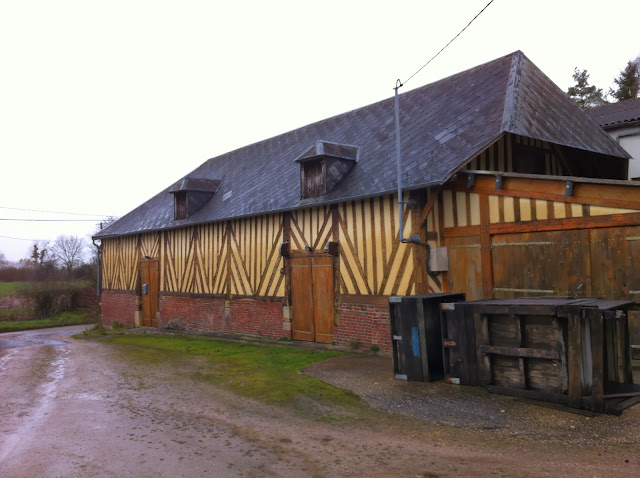In Normandy
If you're familiar with American cider-making, the English tradition is pretty straightforward. Nearly all American cider makers pitch yeast, but otherwise, the contours are familiar. French cider making takes you another step (or three) into the unknown.
French ciders are comparatively weak, ranging from less than three percent (doux, sweet) to about five (brut, dry). They are all sweet by comparison, though on the stronger end the tannins offer plenty of balance. And they're effervescent, with a pop of the cork reminiscent of champagne.
They achieve this by the strange technique of keeving ("defecation" in French, so I'll stick with the English). I have been trying to wrap my brain around descriptions I've read, so was glad to have Guillaume Drouin walk me through his process. Everything proceeds as normal through the pressing stage. Drouin has several dozen varieties of apples, all of them unfamiliar to my ear (especially as it rolled mellifluously from his tongue), but mainly bittersweets They are collected at three times from late September through December and pressed: then begins the interesting stuff.
After grinding the apples into a pulp, they are macerated--or left to sit for a period of time. This is said to soften the tannins as the pulp oxidizes. (You'll forgive me if I get some of the science wrong here--I haven't had a chance to review the tape and am working from memory. I believe something happens enzymatically to the pectins as well.) Not everyone agrees that it works, but Guillaume, who trained as a winemaker before returning to Normandy, has tried it both ways and is convinced maceration works.
Once the juice is pressed, he chills it to 46F / 8C and sends it to the fermenter. Then the magic happens. The pectins (I think) rise, forming a "brown hat" that steadily compresses. The cider maker tests the chapeau by climbing to the top of the fermenter and poking it with a stick, testing the resistance. When it's ready, They rack the clarified cider from the bottom of the fermenter until the hat descends fully.
Thereafter, Guillaume works to stress the cider, keeping it cold and racking it over and over again, forcing the yeast to repopulate. If the temperature rises above 52F / 11C, he will chill it again. Eventually, the yeast essentially gives up, coming to a gravity of the maker's choosing. The cider starts with a gravity of 1052-1056 (it depends on the sugar content of the apples) and will finish as high as 1025. A "dry" cider is 1012-1015. (In England, dry ciders range from 0.098 to 1005).
As with Belgian beer, the cider goes through a refermentation in the bottle. Guillaume expressed exactly the same sentiments as the Belgians: without this stage, the flavors won't develop and mature.
I spent an afternoon with Cyril Zangs, who doesn't use keeving to make his cider. Like other French cider makers, he does naturally condition his ciders. He also practices the peculiarly French technique of "disgorgement" used to make champagne--though this seems to be unusual for cider.
In disgorgement, the cider is fermented on its side, so the yeast collects lengthwise. Then the bottles are placed in racks, arse-end up at about a 45 degree angle. Gravity slowly pulls the yeast to the neck. Over the course of weeks, the bottles are regularly rotated a quarter turn or so to encourage the yeast down the bottle. They have to go slowly so the powdery yeast is helped down by the heavier yeast and doesn't drift off in solution. At the end of the process, there's a little plug of yeast in the neck.
This is when the cider make disgorges it--opening the cap so the plug is blown out. They do this in winter, when the cider is sluggish and cold, so there's not a huge loss of carbonation. They take one of the bottles to top off the others, cork and cage and they're done. M. Zangs claimed not to make typical French cider--and he doesn't. His ciders are drier and finished like champagne. On the other hand, the way he makes cider seems uniquely French.
I encourage you to go buy a bottle of whatever French cider you can find. They share some similarities no matter how different they are. The apples are of a place. I can't exactly describe them, but you'll begin to recognize their character. The nose usually contains a bit of refined wildness, a waft of fromage. The body is mousse-like but delicate with bubbles. Altogether different from Engliah cider, but somehow familiar.
Photos: Drouin fermenters; old Drouin press; Zangs cidery.


